


xxxxxAs we have seen (1810 G3c), by 1818 the Spanish colonies in the southern region of South America -
SIMON BOLIVAR 1783 -
(G3b, G3c, G4, W4)
Acknowledgements
Bolivar: by the Venezuelan painter Arturo Michelena (1863-
xxxxxAs we have seen (1810 G3c), by 1818 the Spanish colonies in the southern area of South America -
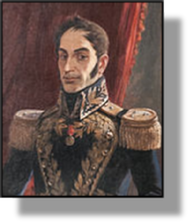
xxxxxBolivar was born into a wealthy family in Caracas, Venezuela. After private tuition he was sent to Europe at the age of 16, and spent three years in Spain. In 1801 he married and returned to Caracas but, following his wife’s sudden death from fever, he returned to Europe in 1804. It was then, while studying in Paris, that he read the works of such political philosophers as Locke, Hobbes, Voltaire and Rousseau. Perhaps not surprisingly, he returned to Venezuela in 1807 determined to liberate his country from Spanish rule.
xxxxxHe did not have long to wait. With the fall of the Spanish monarchy in 1810 the fight for independence in Venezuela began in earnest. A republic was declared in July 1811, and when its military dictator Francisco de Miranda was captured by the Spanish the following year, Bolivar quickly emerged as the champion of liberty and the new revolutionary leader. In a series of hard-
xxxxxOn returning to Venezuela, he established his headquarters at Angostura in the Orinoco region, a fairly remote and safe area. There he continued the fight, assisted with money and weapons from the little republic of Haiti. However, making little real progress, in the spring of 1819 he decided to make a surprise attack upon the Spanish viceroyalty of New Granada (today’s Colombia). Itxwas a stroke of genius, and proved the turning point in the struggle for independence. In a feat of endurance which has gone down in the annals of military history, he led a force of no more than 2,500 men across flooded lowlands and treacherous mountain passes, and, by so doing, caught the Spaniards completely off their guard. At the Battle of Boyaca in August 1819 they were routed and forced to surrender. Three days later Bolivar entered the capital of Bogota.
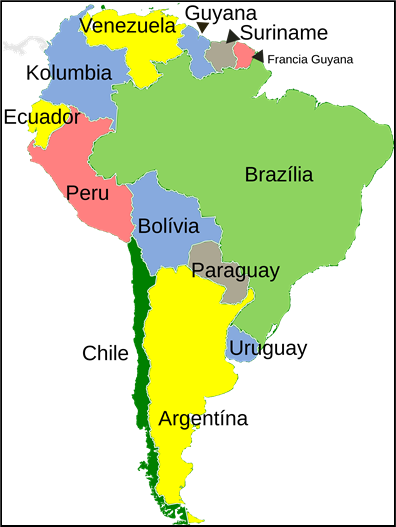 xxxxxOnxthe strength of this stunning victory Bolivar took the fight into his homeland, Venezuela. At the Battle of Carabobo in June 1821 he inflicted another defeat on the royalist forces, and once again entered Caracas in triumph, but this time with victory assured. Having achieved his paramount aim -
xxxxxOnxthe strength of this stunning victory Bolivar took the fight into his homeland, Venezuela. At the Battle of Carabobo in June 1821 he inflicted another defeat on the royalist forces, and once again entered Caracas in triumph, but this time with victory assured. Having achieved his paramount aim -
xxxxxNow only Peru remained in Spanish hands. There, the revolutionary leader José de San Martin, who, as we have seen earlier (1810 G3c), had played a major part in the liberation of Argentina and Chile, was already in possession of Lima. In September 1820 he had landed on the Peruvian coast with 6000 men, defeated a Spanish army at Pisco in the December, and then occupied the capital. From here he proclaimed Peru’s independence in July 1821, and was appointed the country’s protector. However, the Spanish, retreating into the mountains, remained a considerable threat, and Bolivar’s army was clearly needed if the country were to be liberated. In July 1822, the two men, San Martin and Bolivar, met at the port of Guayaquil in Ecuador to discuss tactics and the political future of the new independent states, but there was no meeting of minds. San Martin had no sympathy with the authoritarian attitude adopted by Bolivar and, on leaving Guayaquil, went into exile, living the remainder of his life in Europe.
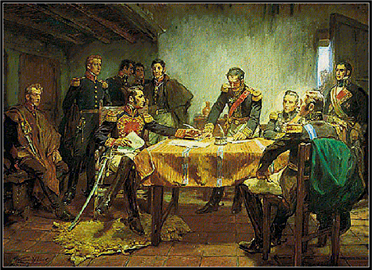 xxxxxIt was left to Bolivar to take on the Spaniards and complete the liberation of Latin America. This he did, showing consummate military skill. On arrival at Lima in September 1823 he assembled an army to flush the Spanish out of the mountains. Havingxwon the major battle at Junin, high in the Cordilleras, a further victory was achieved by Sucre at the Battle of Ayachucho in December 1824. Here the Spanish viceroy surrendered his entire army. (illustrated). The final campaign ended with the liberation of Upper Peru in January 1825 and, later that year, this region became known as Bolivia in honour of its liberator.
xxxxxIt was left to Bolivar to take on the Spaniards and complete the liberation of Latin America. This he did, showing consummate military skill. On arrival at Lima in September 1823 he assembled an army to flush the Spanish out of the mountains. Havingxwon the major battle at Junin, high in the Cordilleras, a further victory was achieved by Sucre at the Battle of Ayachucho in December 1824. Here the Spanish viceroy surrendered his entire army. (illustrated). The final campaign ended with the liberation of Upper Peru in January 1825 and, later that year, this region became known as Bolivia in honour of its liberator.
xxxxxBolivar was now at the height of his power, president of both Gran Colombia and Bolivia. But his dictatorial measures won him few friends, and his obsessive idea of a league made up of the former Spanish colonies, convened in 1826, met with limited success. In that year war broke out across much of the region. Venezuela and Ecuador succeeded from the republic of Gran Colombia, and Peru attempted to seize land from Ecuador. Early in 1830 Bolivar, unable to pacify the rival factions, resigned as president-
xxxxxThe last Spanish colony in South America to obtain its independence was Uruguay. Choosing to fight its own battles back in 1810, it fell under the control of its neighbour Brazil in 1821, and did not become a sovereign state until 1828. Brazil itself, the one Portuguese colony on the continent, was granted independence by Dom Pedro, son of King John VI, in October 1822. However, the country retained a monarchy -
xxxxxAlthough revered today as South America’s greatest liberator -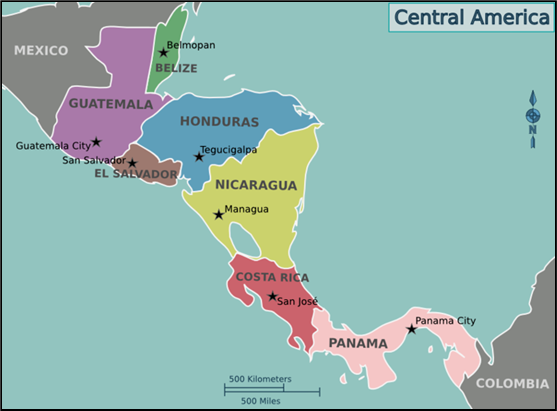
xxxxxNor was the situation any better in Central America. Here, independence from Spanish rule was achieved in 1821 and two years later the United Provinces of Central America was formed, made up of Guatemala, El Salvador, Honduras, Nicaragua, and Costa Rica (Panama remained part of Colombia). This broke up, however, in 1838, and in each state there followed a power struggle between the conservatives -
xxxxxIncidentally, we are told that when Bolivar was studying in Europe as a young man he visited Rome and, standing on the heights of the Monte Sacro, swore an oath that he would not allow his arm to rest nor his soul to die until he had liberated South America from Spanish dominion. He was true to his word. ……
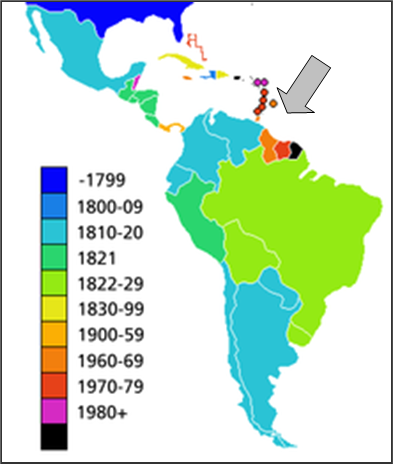
xxxxx…… The name Peru is thought to derive from a native Indian word meaning “land of abundance” -
xxxxx…… As we have seen, it was this struggle for independence from Spain and Portugal, and the fear that other reactionary countries in Europe might intervene to help maintain these colonial possessions, which triggered off the Monroe Doctrine in 1823. ……
xxxxx…… As the map shows (arrowed), a few colonies did not gain independence until the 20th Century. Panama from Colombia in 1903; Trinidad and Tobago from the United Kingdom in 1962; Guyana from the United Kingdom in 1966; and Surinam from the Dutch in 1975. French Guiana remains an overseas department of France.
Including independence for: New Granada,
Venezuela, Ecuador, Peru, Bolivia,
Uruguay, Brazil and Central America.

G4-


